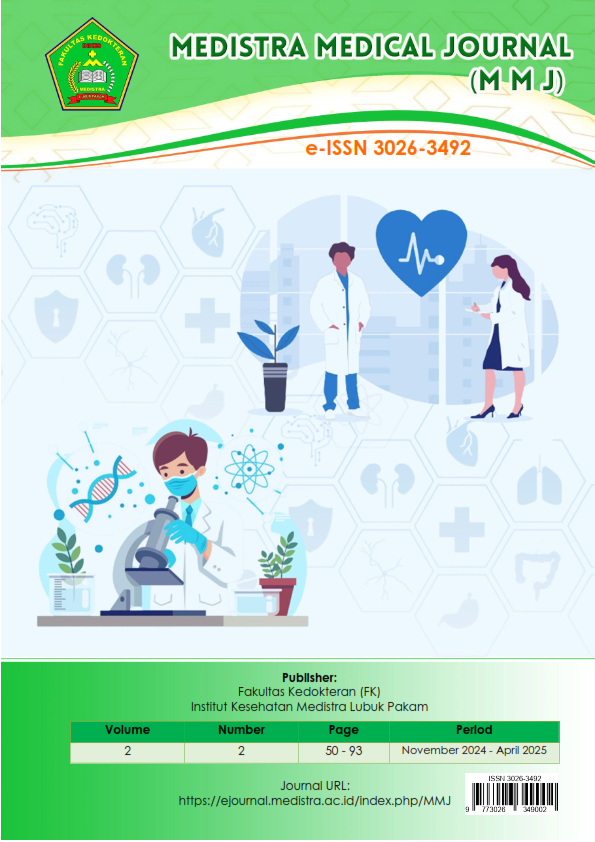A Community-Based Disaster Preparedness-Based Catastrophic Emergency Management Model at Grandmed Lubuk Pakam Hospital in 2023
DOI:
https://doi.org/10.35451/ds7gh439Keywords:
Manajemen Bencana; Kegawatdaruratan Katastropik; Rumah Sakit; Community-Based Disaster Preparedness.Abstract
Hospitals, as vital facilities in the healthcare service system, play a crucial role in responding to disaster events, particularly large-scale catastrophic disasters. However, many hospitals in Indonesia still lack an integrated emergency management system that incorporates a community-based approach (Community-Based Disaster Preparedness/CBDP). This study aims to design a catastrophic emergency management model based on CBDP at RSU Grandmed Lubuk Pakam. This research is a qualitative study using an exploratory case study approach. Data collection techniques included in-depth interviews, participatory observations, and document reviews involving key informants such as hospital management, healthcare workers, surrounding community members, and related institutions such as BPBD and PMI. Data were analyzed thematically using the Miles & Huberman model. The results show that although RSU Grandmed has established a disaster management structure, its implementation has not been optimal due to weaknesses in training, coordination, and SOP comprehension. Community involvement in preparedness systems remains minimal, and cross-sectoral coordination has not been formally established.
References
[1] Badan Nasional Penanggulangan Bencana (BNPB). (2022). Data dan Informasi Bencana Indonesia Tahun 2022. Jakarta: BNPB.
[2] World Health Organization (WHO). (2021). Hospital Emergency Response Checklist: An All-Hazards Tool for Hospital Administrators and Emergency Managers. Geneva: WHO.
[3] Nugroho, S. P. (2019). Strategi Manajemen Bencana Rumah Sakit: Konsep dan Implementasi. Jakarta: EGC.
[4] Twigg, J. (2015). Disaster Risk Reduction: Mitigation and Preparedness in Development and Emergency Programming. London: Humanitarian Practice Network.
[5] Kusumasari, B. (2014). Manajemen Bencana: Pendekatan Kelembagaan dan Kesiapsiagaan Pemerintah Daerah dalam Pengurangan Risiko Bencana. Yogyakarta: Gava Media.
[6] Kementerian Kesehatan RI. (2021). Pedoman Kesiapsiagaan Rumah Sakit dalam Menghadapi Bencana. Jakarta: Kemenkes RI.
[7] Wisner, B., Gaillard, J. C., & Kelman, I. (2012). Handbook of Hazards and Disaster Risk Reduction and Management. New York: Routledge.
[8] Setiawan, A. (2020). “Penerapan CBDP dalam Penanggulangan Bencana di Fasilitas Kesehatan.” Jurnal Manajemen Bencana Indonesia, 6(2), 85–93.
[9] PAHO/WHO. (2010). Hospital Safety Index: Evaluation Forms. Washington D.C.: Pan American Health Organization.
[10] BNPB. (2012). Pedoman Umum Pengurangan Risiko Bencana Berbasis Komunitas. Jakarta: Badan Nasional Penanggulangan Bencana.
[11] Luna, E. M. (2009). Community-based disaster risk reduction and disaster management. In Approaches to Disaster Management. Springer.
[12] Arsi Susilawati, Ferry Efendi, Setho Hadisuyatmana. (2019). Description Preparedness of Health Workers in Disaster Management in Public Health Center Disaster Vulnerable Area. Indonesian Journal of Community Health Nursing, Vol. 4 No. 1.
[13] Krisnawati Gulo, Syahirul Alim, Madelina Ariani. (2022). Analisis Kesiapsiagaan Manajemen Kegawatdaruratan dan Bencana Berdasarkan Hospital Safety Index (HSI) PAHO/WHO di RS DKT Dr. Soetarto Yogyakarta. Tesis, Universitas Gadjah Mada.
Downloads
Published
Issue
Section
License
Copyright (c) 2025 Ganda Impola

This work is licensed under a Creative Commons Attribution 4.0 International License.
Copyright in each article is the property of the Author.
















